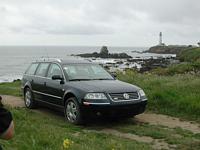Review : 2003 VW Passat W8
SEE ALSO: Volkswagen Buyer's Guide
THE AUTO PAGE
By
JOHN HEILIG
SPECIFICATIONS
MODEL: Volkswagen Passat W8
ENGINE: 4.0-liter W-8
HORSEPOWER/TORQUE: 270 hp @ 6000 rpm/273 lb-ft @ 2750 rpm
TRANSMISSION: Five-speed automatic
WHEELBASE: 106.4 in.
LENGTH x WIDTH x HEIGHT: 185.2 x 68.7 x 57.5 in.
STICKER PRICE: $37,000 (est.)
The big news with the Volkswagen Passat is all under the hood. The car
itself was mildly restyled a year ago as a 2001.5 model. The redesign, while
minor, freshened the Passat and made it more aerodynamic.
However, the largest engine previously available in the Passat was a
2.8-liter V-6 that produced 190 horsepower. And while this was a decent
amount of power for an engine of that capacity, there were still some drivers
who were looking for more power.
In Germany, VW installed its new W-8 engine in the Passat about a year
ago and silenced all the critics who wanted more power. Now the W-8 engine is
available in North America, and it's a great package.
How did VW construct the engine and why is it called a W-8? VW has had
its narrow Vee VR6 engine for quite some time. This is a V-6 engine, but the
angle between the banks of cylinders is only 15 degrees (in most V engines
the angle between the cylinders is 60 or 90 degrees), so only one cylinder
head is used. The cylinders actually overlap slightly.
To create the W-8, VW connected two VR6 engines in a V configuration,
creating a 12-cylinder engine, a W-12. They then "cut off" two cylinders from
each bank to make the W-8. The W-8 is actually two narrow V V-4 engines, and
in Spanish (don't forget that VW owns Real, a Spanish automaker), vehdoble
(literally v double) means W. In cutaway, the engine looks like four
two-cylinder engines. Again, the angle between the banks of cylinders in each
individual V is narrow. The cylinders must be interlaced. They can't be in a
straight line.
Incidentally, Volkswagen plans to use the W-12 in the new Bugatti (yes,
VW owns that, too) and in a Bentley performance car.
The resulting W-8 engine is a 4.0-liter eight developing 270 horsepower
and 273 foot-pounds of torque. It's extremely short, shorter even than the
V-6. Therefore, the body of the Passat needed no modifications for the larger
(in internal capacity and power) engine.
With the new engine, the Passat gives you the feeling it can outrun
anything else on the road, and it doesn't need a turbo to do it. In our
introductory test runs over some gorgeous winding roads south of San
Francisco and on Route 1 from Monterey to Half Moon Bay, the only cars that
could keep up with the Passat W8 were other Passat W8s.
The engine puts the power to the road through a five-speed automatic
transmission with Tiptronic that allows the driver to shift if he or she
wants to. The Passat W8 also has 4Motion, Volkswagen's all-wheel drive
system. We did a little "off roading" for some photographs and the 4Motion
kept us out of trouble, no matter how hard I tried to get in.
Two models are being offered for the North American market, a four-door
sedan and a four-door wagon. Later in the calendar year a sport package will
be available with 17-inch wheels and a six-speed manual transmission.
With a price tag in the upper $30,000 range, this is the most expensive
Volkswagen ever sold. It does expand Volkswagen's product lineup. It's a
great expansion, but we can only wonder if consumers will be willing to pony
up that amount of money for a Volkswagen.
© 2002 The Auto Page Syndicate



